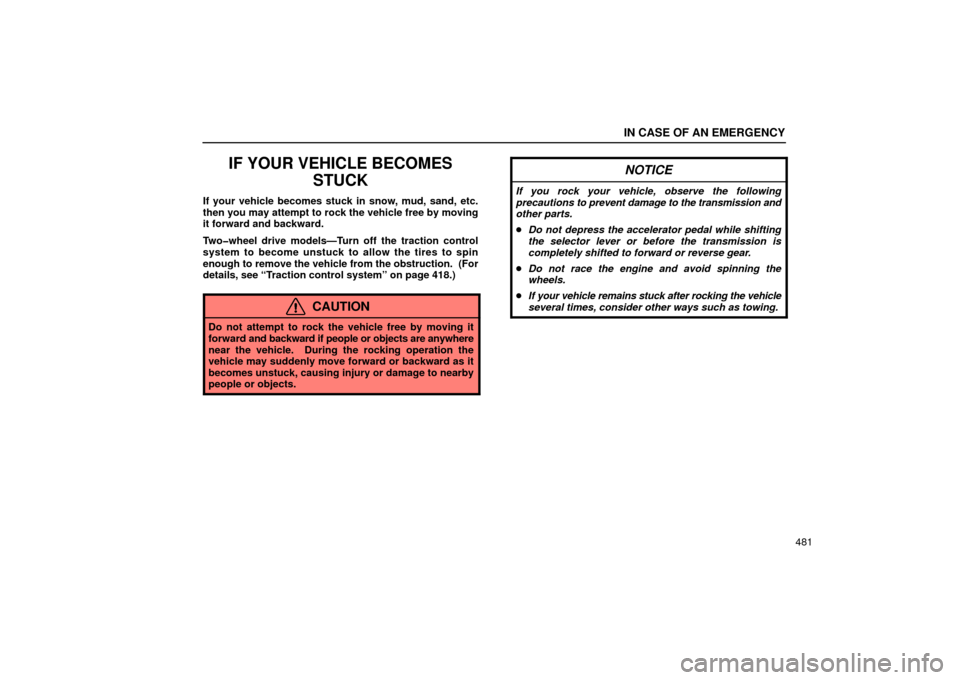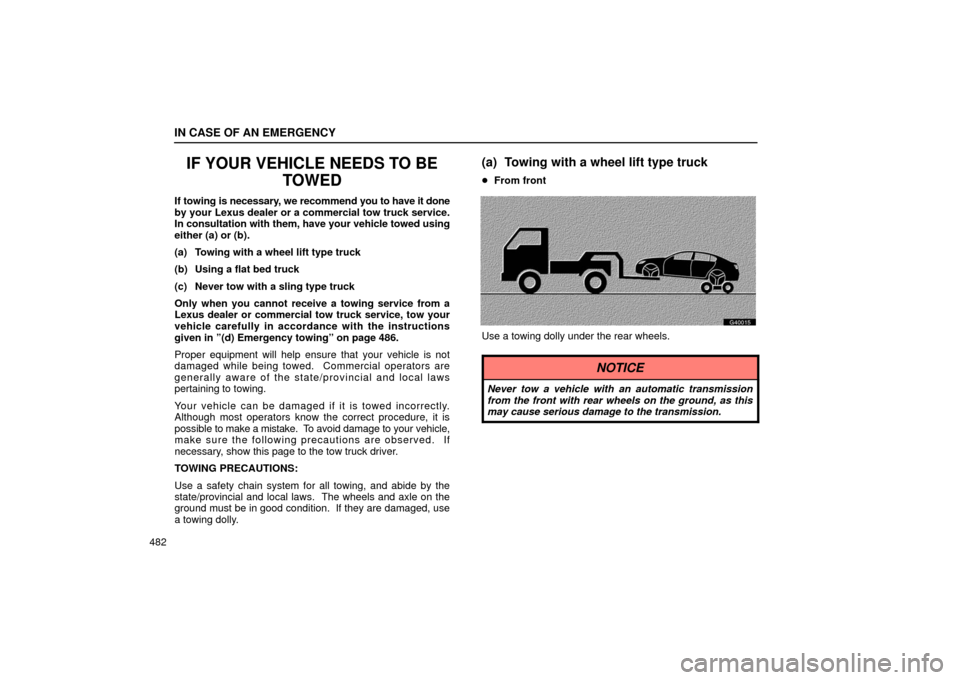Page 477 of 622

DRIVING TIPS
456
VEHICLE LOAD LIMITS
Vehicle load limits include total load capacity, seating
capacity, towing capacity and cargo capacity . Follow the
load limits shown below. Total load capacity and seating
capacity are also described on the tire and loading
information label. For location of the tire and loading
information label, see “Checking tire inflation pressure”
on page 539.
Total load capacity: 370 kg (815 lb.)
Total load capacity means combined weight of
occupants, cargo and luggage.
Seating capacity: Total 5 (Front 2, Rear 3)
Seating capacity means the maximum number of
occupants whose estimated average weight is 68 kg
(150 lb.) per person. Depending on the weight of each
person, the seating capacity given may exceed the total
load capacity.
NOTICE
Even if the number of occupants are within the
seating capacity, do not exceed the total load
capacity.
Towing capacity
Lexus does not recommend towing a trailer with your
vehicle. Your vehicle is not designed for trailer towing.
Cargo capacity
Cargo capacity may increase or decrease depending on
the size (weight) and the number of occupants. For
details, see “Capacity and distribution” that follows.
CAUTION
Do not apply the load more than each load limit.
That may cause not only damage to the tires, but
also deterioration to the steering ability and
braking ability, which may cause an accident.
Page 478 of 622

DRIVING TIPS
457
CARGO AND LUGGAGE
Stowage precautions
When stowing cargo and luggage in the vehicle,
observe the following:
�Put cargo and luggage in the trunk when at all
possible. Be sure all items are secured in place.
� Be careful to keep the vehicle level. Placing the
weight as far forward as possible helps maintain
vehicle balance.
� For better fuel economy, do not carry unnecessary
weight.
CAUTION
�Do not place anything on the package tray
behind the rear seatback. Such items may be
thrown about and possibly injure people in the
vehicle during sudden braking or an accident.
� Do not drive with objects left on top of the
instrument panel. They may interfere with the
driver’s field of view. Or they may move during
sharp vehicle acceleration or turning, and
impair the driver’s control of the vehicle. In an
accident they may injure the vehicle occupants.
NOTICE
Do not load the vehicle beyond the vehicle
capacity weight specified on the tire and loading
information label.
Page 479 of 622

DRIVING TIPS
458
Capacity and distribution
Cargo capacity depends on the total weight of the
occupants.
(Cargo capacity) = (Total load capacity) – (Total weight
of occupants)
Steps for determining correct load limit
1. Locate the statement “The combined weight of
occupants and cargo should never exceed XXX pounds”
on your vehicle’s placard.
2. Determine the combined weight of the driver and
passengers that will be riding in your vehicle.
3. Subtract the combined weight of the driver and
passengers from XXX kilograms or XXX pounds.
4. The resulting figure equals the available amount of
cargo and luggage load capacity. For example, if the
“XXX” amount equals 1400 lbs. and there will be five 150
lb. passengers in your vehicle, the amount of available
cargo and luggage load capacity is 650 lbs. 1400 – 750
(5 x 150) = 650 lbs.
5. Determine the combined weight of luggage and cargo
being loaded on the vehicle. That weight may not safely
exceed the available cargo and luggage load capacity
calculated in Step 4. 6. If your vehicle will be towing a trailer, load from your
trailer will be transferred to your vehicle. Consult this
manual to determine how this reduces the available
cargo and luggage load capacity of your vehicle.
Lexus does not recommend towing a trailer with your
vehicle. Your vehicle is not designed for trailer towing.
Page 482 of 622

SECTION 4
461
IN CASE OF AN EMERGENCY
In case of an emergency
If your engine stalls while driving462
. . . . . . . . . . . . . . . . . . . . . . . . . . .
If your vehicle will not start 462
. . . . . . . . . . . . . . . . . . . . . . . . . . . . . . . .
If you cannot increase engine speed 466
. . . . . . . . . . . . . . . . . . . . . . . .
If your vehicle overheats 467
. . . . . . . . . . . . . . . . . . . . . . . . . . . . . . . . . .
If you have a flat tire (vehicles with run −flat tires) 468
. . . . . . . . . . . . .
If you have a flat tire (vehicles with standard tires) 469
. . . . . . . . . . . .
If your vehicle becomes stuck 481
. . . . . . . . . . . . . . . . . . . . . . . . . . . . .
If your vehicle needs to be towed 482
. . . . . . . . . . . . . . . . . . . . . . . . . .
If you cannot shift automatic transmission
selector lever 489
. . . . . . . . . . . . . . . . . . . . . . . . . . . . . . . . . . . . .\
. . . . . . .
If you lose your keys or lock yourself out 490
. . . . . . . . . . . . . . . . . . . .
Page 495 of 622
IN CASE OF AN EMERGENCY
474
G40005
When closing the board, replace the hook also in its
original position as shown.
NOTICE
If you close the trunk lid with the board hooked,
the hook may be damaged.
G40023
� 1Wrench
2Towing eyelet (for emergency towing)
3Jack handle
4Screwdriver
5Spare tire
6Wrenches
7Pliers
8Jack
3. Get the jack, wrench and spare tire.
To prepare yourself for an emergency, you should
familiarize yourself with the use of the jack and each tool,
and their storage locations.
Page 501 of 622

IN CASE OF AN EMERGENCY
480
CAUTION
�When lowering the vehicle, make sure all
portions of your body and all other persons
around will not be injured as the vehicle is
lowered to the ground.
� Have the wheel nuts tightened with torque
wrench to 103 N·m (10.5 kgf·m, 76 ft·lbf.), as
soon as possible after changing wheels.
Otherwise, the nuts may loosen and the wheels
may fall off, which could cause a serious
accident.
� Do not attach a heavily damaged plastic wheel
ornament. It may fly off the wheel and cause
accidents while the vehicle is moving.
11. After changing the wheel, check the air
pressure of the replaced tire. Stow all the tools, jack
and flat tire securely.
If the inflation pressure of the replaced tire is low, drive
slowly to the nearest service station and fill to the correct
pressure.
Do not forget to reinstall the tire valve cap as dirt and
moisture could get into the valve core and possibly
cause air leakage. If the cap is missing, put a new one
on as soon as possible.
This is the same procedure for changing or rotating your
tires.
CAUTION
Before driving, make sure all the tools, jack and
flat tire are securely in place in their storage
location to reduce the possibility of personal
injury during a collision or sudden braking.
Page 502 of 622

IN CASE OF AN EMERGENCY
481
IF YOUR VEHICLE BECOMESSTUCK
If your vehicle becomes stuck in snow, mud, sand, etc.
then you may attempt to rock the vehicle free by moving
it forward and backward.
Two�wheel drive models—Turn off the traction control
system to become unstuck to allow the tires to spin
enough to remove the vehicle from the obstruction. (For
details, see “Traction control system” on page 418.)
CAUTION
Do not attempt to rock the vehicle free by moving it
forward and backward if people or objects are anywhere
near the vehicle. During the rocking operation the
vehicle may suddenly move forward or backward as it
becomes unstuck, causing injury or damage to nearby
people or objects.
NOTICE
If you rock your vehicle, observe the following
precautions to prevent damage to the transmission and
other parts.
� Do not depress the accelerator pedal while shifting
the selector lever or before the transmission is
completely shifted to forward or reverse gear.
� Do not race the engine and avoid spinning the
wheels.
� If your vehicle remains stuck after rocking the vehicle
several times, consider other ways such as towing.
Page 503 of 622

IN CASE OF AN EMERGENCY
482
IF YOUR VEHICLE NEEDS TO BETOWED
If towing is necessary, we recommend you to have it done
by your Lexus dealer or a commercial tow truck service.
In consultation with them, have your vehicle towed using
either (a) or (b).
(a) Towing with a wheel lift type truck
(b) Using a flat bed truck
(c) Never tow with a sling type truck
Only when you cannot receive a towing service from a
Lexus dealer or commercial tow truck service, tow your
vehicle carefully in accordance with the instructions
given in ”(d) Emergency towing” on page 486.
Proper equipment will help ensure that your vehicle is not
damaged while being towed. Commercial operators are
generally aware of the state/provincial and local laws
pertaining to towing.
Your vehicle can be damaged if it is towed incorrectly.
Although most operators know the correct procedure, it is
possible to make a mistake. To avoid damage to your vehicle,
make sure the following precautions are observed. If
necessary, show this page to the tow truck driver.
TOWING PRECAUTIONS:
Use a safety chain system for all towing, and abide by the
state/provincial and local laws. The wheels and axle on the
ground must be in good condition. If they are damaged, use
a towing dolly.
(a) Towing with a wheel lift type truck
� From front
G40015
Use a towing dolly under the rear wheels.
NOTICE
Never tow a vehicle with an automatic transmission
from the front with rear wheels on the ground, as this
may cause serious damage to the transmission.